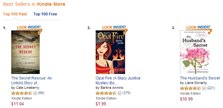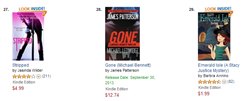Posted on 2013-Aug-23
Self-Publishing for Everyone

If you are a frequent reader of this site, you may either be a general visitor who has a keen interest in digital publishing, an avid reader who wants to expose to the growing eBook catalog, an independent author who is willing to turn your manuscripts into a polished gem readily packaged to be sold on online bookstores, and/or a small press to contract out digitizing the existing catalog to be sold directly to online bookstores or customers. The list suggests the open-ended possibility that anybody can study the evolving publishing industry for their own knowledge with benefits.
eBook Revolution 2.0
Being tipped by Joanna Penn earlier yesterday on The Alliance of Independent Authors’ private Facebook board, this recently posted piece from BBC about eBook sand self-publishing again clarifies what self-publishers are known for; that is, connecting directly with their target audience and imposing a strict quality check. To think of self-publishing as a trending business is an underestimation of what the real potential in the business can have an everlasting impact on readers and authors.
Traditional Limitation

Having had very little opportunity to release their work directly to cater to their reader’s demand, authors in the traditional sense (traditionally published) are obligated to work with a ‘gatekeeper’ to get their books distributed to the public audience hoping that their books will somehow reach the supportive buyers and they can put their share of royalties earnings to good use. This can be a frustrating process, and many authors have decided to go the indie route.
Overcoming Rejection Letters

Things may not be rosy for a debut author who may struggle to convince their gatekeeper to accept their potentially sellable material. Rejection letters are bitter outcomes to deny the author’s access to the publishing world. While reasons may vary, authors instinctively know that they have to move on and find some other alternative route to explore. Self-publishing is one fine option that authors can rely on and succeed.
How Paul Pilkington Succeeds
With rigorous control of each and every process ranging from designing book covers to distribution to as many vendors as possible, Paul Pilkington flexibly took his first eBook to top the free download chart on Amazon. His second book scored well in the paid chart and he is working on a third one enthusiastically. So far, he has sold more than 160,000 books with the exclusive record of 2.2 million free downloads. Regardless of his self-publishing hits, he has just signed with a publisher to sell his books in the UK.
Joanna Penn: The Multi-Talented Consultant
Joanna Penn has a somewhat different story to tell. She worked in her day job miserably and wanted to quit since she had realized her love of reading. Being initially unaware of her writing craft, the technology changed her professional scenario and allowed her to invest some quality time in thrillers instead of crunching numbers. Apart from selling her own books, Joanna collaborates industriously with independent authors to teach about how they can sell more books through self-publishing model. Her video interviews constantly prove that the community of indie authors is tight-knit and helpful for everyone to join and learn.
Barbra Annino: Bestselling Self-publisher to Watch
Another successful case of an indie author whose four books are simultaneously in Amazon’s Top 100 Paid chart (#2, #29, #42, #47) in Kindle store. Barbra Annino is one woman who has had a strong faith in self-publishing and did her homework well to adjust her work quality to perfect her art. Based on Google’s search results of her self-publishing journey, last year was a busy time for her to sell her book. Like most indie authors, this year’s success came with a hardworking backstory how she created her books and tailored to perfection. She revealed the secret behind the scenes of her first book how she learnt new skills to design her own cover yet editing was one of the most significant elements that required professional help. “Don’t trust it’s perfect because your mom said so. Send that baby out to as many people as you can bother [my italics],” Barbra amusingly advised.




Book Recommendation Websites
Unlike the physical books that require readers to go to the bookstore to browse the books, after the eBook is launched on the virtual shelf, there is no limit that your book might be picked up by readers and featured on book recommendation websites. Amazon, Bookish, Goodreads are the ideal samples, just to name a few. Isabel Farhi posted ‘Top Ten Book Recommendation Platforms’ on Digital Book World. Going through each and every link included in the list, chances are you are not likely to walk away empty-handed where tons of eBooks awaiting your discovery paid and free. Different sites showcase different interfaces but the basic function is to offer books for maximum exposure. If you find the sites too overwhelming to digest, try adding our simple and clean interface on Substance B to your reading collection for this weekend. For authors, we offer a simplistic way for you to take full control of your book promotion and connect with your fans through inscribed eBook and free eBook sample.
Prioritize Your Readers

The abovementioned stories are not the mere testimonies how self-publishing can work for all authors and aspiring writers. Being able to self-publish helps you to communicate directly with readers without unnecessary intervention and regulations. Although rejection letters may be nonexistent among self-publishers, the priority must always remain establishing a solid connection and trust with readers whose support can immensely change their lives. Needless to say, self-publishing with an eBook is a good way to go.
Label: Self-Publishing
comments powered by Disqus